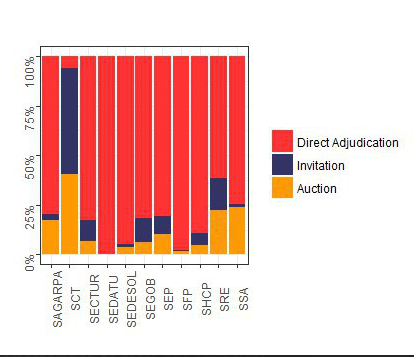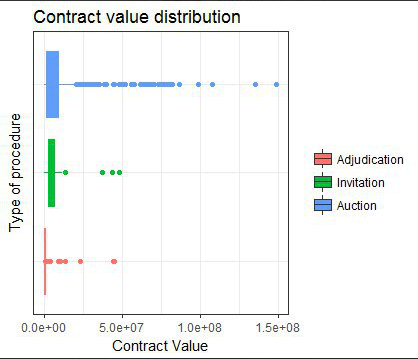3 Background
3.1 Corruption in Mexico
According to the Organization for Economic Cooperation and Development (OECD), developed economies spend, on average, 12% of their Gross Domestic Product (GDP) on public purchases. In Mexico, such purchases account for 11% to 12% of the GDP and represent between 30% and 40% of government expenses [gonzalez2015] [unodc2014].
In Mexico, public purchases is one of the governmental activities with more risk of corruption, fraud, illicit enrichment and lack of competition despite being subject to standardized processes and being regulated by the Ley de Adquisiciones, Arrendamientos y Servicios del Sector Público, Ley de Obras Públicas y Servicios, and Ley Federal de Competencia Económica.
Legal dispositions on public purchases give preference to adjudication through public licitations, which allow for the development of an effective competition environment. However, despite the budgetary constraints imposed over direct adjudications, they are very common in some dependencies which evade the budgetary constraints adjudicating atomized contracts. Even when the adjudication is made through public licitations, there are some known cases of collusion among providers which lead to higher prices for the good or service being provided to the government. As collusion is not easily detected, procurement regulation has become increasingly complex. Even with the increased complexity, the government has not been able to identify collusion among providers and the procurements have been hindered by bureaucratic processes that increase proposal and delivery times and do not benefit the quality of the good or service being provided. The Auditoria Superior de la Federacion has declared that even if regulation is fulfilled, contracts don’t pose a net benefit for the State [asf2014]. Several academics [boyer2015] [connor2008] calculate that lack of competition and collusion among government providers can result in a 17 to 36% overcharge.
knitr::include_graphics("images/grafica1.png")
knitr::include_graphics("images/grafica2.png")
Monitoring illicit activities is not easy because it involves complex strategies, interlined dynamic systems and dynamic patterns that allow the agents to hide them in plain sight and disguise them as licit activities which, in paper, comply with all the regulations. This is why it is necessary to design innovative techniques and methodologies that may identify such patterns. In this sense, we propose to USE data science techniques applied to complex environments and structural analysis to graph networks to identify associations between all different agents involved in public purchases [rababah2017].
3.2 Public Procurement in Mexico
The Mexican government is organized through a de iure federal system. Each year, the Federal Ministry of Finance publishes the official budget proposal -for all agencies within the Public Federal Administration- which is then voted by the Congress. There are similar procedures done at each state to define local budgets throughout the country. Each responsible unit (RU) is then assigned overall budget, some of which will be labeled for a specific purpose (such as infrastructure, security, social development, etc.).
3.2.1 Legal procedures
There are three main types of legal procedures by which RUs may spend their assigned budget.
3.2.1.1 Public Auctions
All public auctions are first-price, sealed-bid auctions. RUs publish the contract specifications in a ”Terms of Reference” document, and are obliged to conduct an official Q&A meeting for potential bidders. Bidders submit their offers, and RUs hold an official proposals disclosure session. RUs publish their adjudication within a 20-day period after the proposals disclosure session. In the official adjudication record, RUs must specify whether any proposal was considered unfit -either technically or in terms of prices- and describe status on each budget item of the contract. If no proposal meets the requirements for a particular budget item, RUs can either run a second auction or, under certain justifications, use another procedure to award the contract. According to the law, public auction is always the first process RUs should consider, and the following two are theoretically done by exception. In practice, however, there are 20 different (and potentially ambiguous) exceptions an RU could call to avoid running an auction.
3.2.1.2 Invitation to at least 3 competitors
The main difference between this and an auction is that RUs get to choose the potential bidders: the criteria and procedures that follow are practically the same. The other two main differences are that the law forbids RUs to award more than 30% of their budget through this procedure and establishes a threshold for the maximum contract value that can be awarded through invitations. These thresholds are defined -in the annual budget plan- for brackets according to the RU’s assigned budget, and hence a particular RU faces slightly different restrictions each year.
3.2.1.3 Direct Adjudications
Whenever an invitation process is declared empty or the contract information is deemed as confidential, RUs can justify directly adjudicating the contract to a given firm, provided they present some sort of market or technology research document to justify the price or the fact that it is a specific technology owned by a particular firm. The same two main constraints for invitations -contracts cannot sum more than 30% of their budget, nor pass a certain value threshold- also apply for adjudications. However, value thresholds are significantly lower for adjudications than for invitations.
3.3 Compranet
Since 2002, the Mexican Federal government handles every procurement process through a transactional website called Compranet. Every procurement must be handled through this platform. An RU within an agency creates the project within the platform and specifies, through Compranet’s preloaded templates or documents previously stored in the platform by the RU (moslty, documents used in previous procurements either by the same RU or by other RUs running similar projects), basic information of the project. The system and the RU must update the information as the process advances and throughout its different stages (from the publication of the project until its completion). Such updates are automatically entered into the database which is updated monthly.